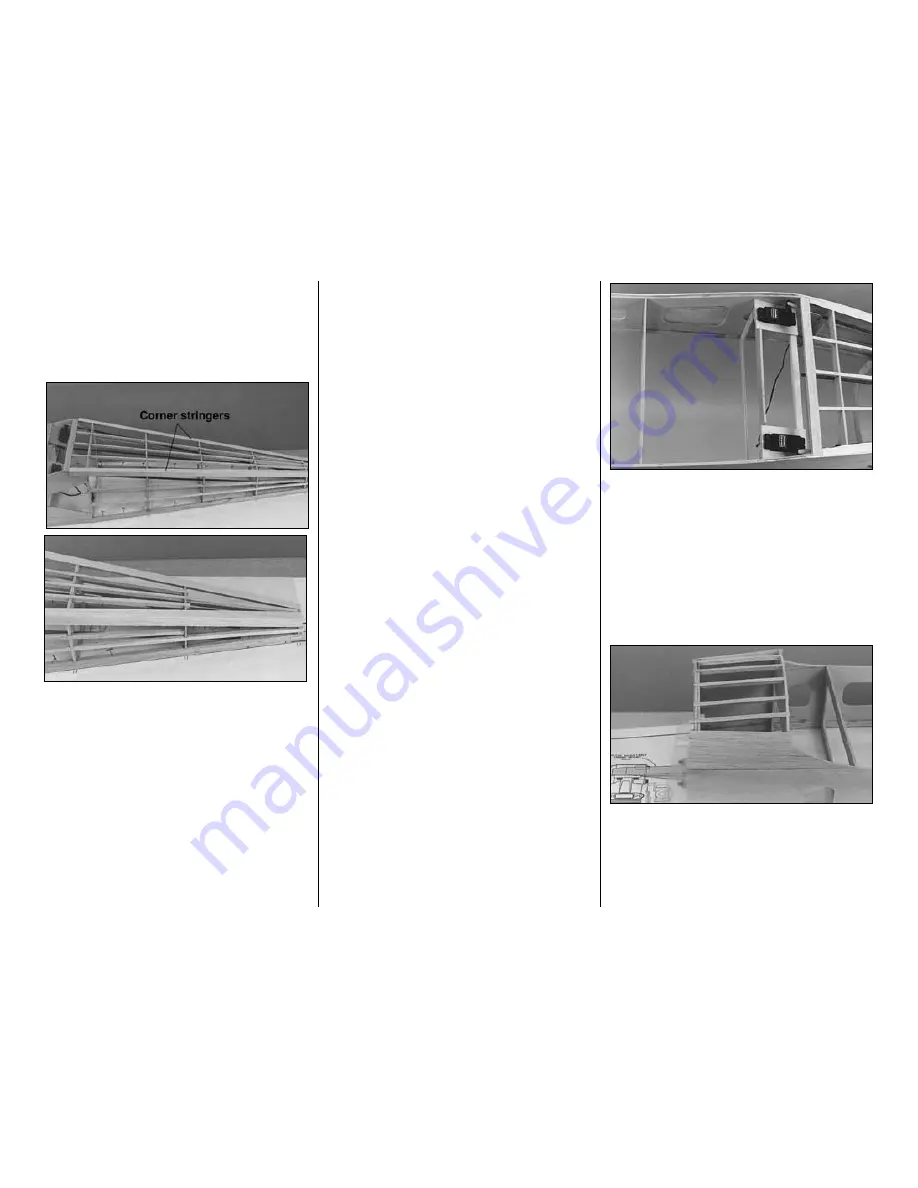
❏
9. Locate two of the 24” [609.6mm] pushrod tubes.
Sand the outside of the tubes so glue will stick. Slide
them through the holes in formers F6 through F10 so
they extend forward of former F6 by [6.4mm] 1/4”. Do
not glue the pushrod tubes in place until instructed to
do so.
❏
10. Glue the 3/16” x 1/2” x 10” [4.8 x 12.7 x
254mm] balsa bottom
fuse sheeting support
in
position. Sand the ends even with the fuse side
doublers. Cut and fit, but
do not glue
the aft bottom
fuse stringers from seven 3/16” x 3/16” x 30” [4.8 x
4.8 x 762mm] balsa sticks to fit in the notches of the
formers as shown on the plan and in the photo. Save
the leftover pieces. The three bottom stringers
extend to the sheeting support. You can see the
stringers in the photo at step 5 page 37.
❏
11. Glue the fronts of the three bottom stringers to
the sheeting support, then use your 90 degree
triangle to hold each former at the correct angle and
glue the bottom stringers to the formers.
❏
12. Glue the 3/16” x 3/16” [4.8mm] side stringers
and pushrod guide tubes to the formers.
❏
13. Cut the bottom
corner stringers
to fit on the
formers where shown on the plan from two 1/2” x 36”
[12.7 x 914mm] balsa triangle sticks. Glue the corner
stringers in place.
MOUNT THE SERVOS
❏
1.
Optional:
For routing your receiver antenna out
the back of the fuselage, cut a third 3/16” [4.8mm]
outer pushrod guide tube (not included) to a length
of 21” [533.4mm]. Roughen the outside of the tube
with coarse sandpaper (so glue will stick) and slide
the tube through the holes in the bottom of the
formers until the front extends past former F7 by
approximately 1/2” [12.7mm]. Glue the tube to the
formers (this tube is visible in the photo at step 5).
❏
2. Before they are installed in the fuselage, test fit
your servos in the
aft servo trays
to make sure they
fit. Glue a servo tray
doubler
to the bottom of the
front
of both trays. The tray is wider at the front than
the rear.
❏
3. Cut an
aft servo tray rail
from a 1/4” x 3/8” x
36” [6.4 x 9.5 x 914mm] basswood stick to fit
between the fuse sides approximately 1-7/8”
[47.6mm] aft of former F5 where shown on the plan.
It will be helpful if you cut the rail to a length that will
provide a
friction fit between the fuse side doublers
so it will temporarily stay in position without using
glue. Position the aft servo tray rail between the fuse
sides.
❏
4. Position your servos into the servo trays and
place the trays on the rail and former F5. Temporarily
thread two nylon clevises just a few turns onto two
36” [914mm] threaded one-end pushrods. Install the
pushrods into the pushrod guide tubes and connect
the clevises to servo arms on your servos.
❏
5. Position the rail and the servo trays so the servo
arms align with the pushrods. Glue the rail and servo
trays to former F5 and the fuse sides in this position.
Drill 1/16” [1.6mm] holes in the servo trays and then
harden the holes with some thin CA. Mount the
servos with the screws, grommets and eyelets that
came with your radio.
FINISH FRAMING THE FUSE
Use this photo for the next two steps.
❏
1. Refer to the photo in the following step and test
fit a die-cut 1/8” [3.2mm] balsa
forward fuse
doubler
on the right side of the fuse. The front edge
of the forward fuse doubler should align with the front
edge of the fuse side doubler. Wet the outer surface
of the doubler and glue it in place. Be sure that
former F2 remains square and flat.
-36-
Содержание T-34B MENTOR
Страница 7: ...7 DIE CUT PATTERNS...
















































